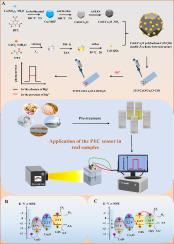当前位置:
X-MOL 学术
›
Food Chem.
›
论文详情
Our official English website, www.x-mol.net, welcomes your
feedback! (Note: you will need to create a separate account there.)
Metal organic framework-derived CuO/Cu2O polyhedron-CdS quantum dots double Z-scheme heterostructure for cathodic photoelectrochemical detection of Hg2+ in food and environment
Food Chemistry ( IF 8.5 ) Pub Date : 2024-04-09 , DOI: 10.1016/j.foodchem.2024.139261 Leixia Meng 1 , Yu Zhang 1 , Jinlong Wang 1 , Bingxin Zhou 2 , Jianjun Shi 3 , Huawei Zhang 4
Food Chemistry ( IF 8.5 ) Pub Date : 2024-04-09 , DOI: 10.1016/j.foodchem.2024.139261 Leixia Meng 1 , Yu Zhang 1 , Jinlong Wang 1 , Bingxin Zhou 2 , Jianjun Shi 3 , Huawei Zhang 4
Affiliation

|
This study employed an innovative copper oxide/cuprous oxide (CuO/CuO) polyhedron‑cadmium sulphide quantum dots (CdS QDs) double -scheme heterostructure as a matrix for the cathodic PEC determination of mercury ions (Hg). First, the CuO/CuO polyhedral composite was prepared by calcining a copper-based metal organic framework (Cu-MOF). Subsequently, the amino-modified CuO/CuO was integrated with mercaptopropionic acid (MPA)-capped CdS QDs to form a CuO/CuO polyhedron-CdS QDs double -scheme heterostructure, producing a strong cathodic photocurrent. Importantly, this heterostructure exhibited a specifically reduced photocurrent for Hg when using CdS QDs as Hg-recognition probe. This was attributed to the extreme destruction of the double -scheme heterostructure and the in situ formation of the CuO/CuO-CdS/HgS heterostructure. Besides, p-type HgS competed with the matrix for electron acceptors, further decreasing the photocurrent. Consequently, Hg was sensitively assayed, with a low detection limit (0.11 pM). The as-prepared PEC sensor was also used to analyse Hg in food and the environment.
中文翻译:

金属有机骨架衍生的CuO/Cu2O多面体-CdS量子点双Z型异质结用于食品和环境中Hg2+的阴极光电化学检测
本研究采用创新的氧化铜/氧化亚铜 (CuO/CuO) 多面体硫化镉量子点 (CdS QD) 双方案异质结构作为阴极 PEC 测定汞离子 (Hg) 的基质。首先,通过煅烧铜基金属有机骨架(Cu-MOF)制备了CuO/CuO多面体复合材料。随后,氨基修饰的CuO/CuO与巯基丙酸(MPA)封端的CdS量子点集成,形成CuO/CuO多面体-CdS量子点双方案异质结构,产生强阴极光电流。重要的是,当使用 CdS QD 作为 Hg 识别探针时,这种异质结构对 Hg 表现出明显降低的光电流。这归因于双方案异质结构的极度破坏和CuO/CuO-CdS/HgS异质结构的原位形成。此外,p型HgS与基质竞争电子受体,进一步降低了光电流。因此,Hg 的检测灵敏度较低,检测限较低 (0.11 pM)。所制备的 PEC 传感器还用于分析食品和环境中的汞。
更新日期:2024-04-09
中文翻译:

金属有机骨架衍生的CuO/Cu2O多面体-CdS量子点双Z型异质结用于食品和环境中Hg2+的阴极光电化学检测
本研究采用创新的氧化铜/氧化亚铜 (CuO/CuO) 多面体硫化镉量子点 (CdS QD) 双方案异质结构作为阴极 PEC 测定汞离子 (Hg) 的基质。首先,通过煅烧铜基金属有机骨架(Cu-MOF)制备了CuO/CuO多面体复合材料。随后,氨基修饰的CuO/CuO与巯基丙酸(MPA)封端的CdS量子点集成,形成CuO/CuO多面体-CdS量子点双方案异质结构,产生强阴极光电流。重要的是,当使用 CdS QD 作为 Hg 识别探针时,这种异质结构对 Hg 表现出明显降低的光电流。这归因于双方案异质结构的极度破坏和CuO/CuO-CdS/HgS异质结构的原位形成。此外,p型HgS与基质竞争电子受体,进一步降低了光电流。因此,Hg 的检测灵敏度较低,检测限较低 (0.11 pM)。所制备的 PEC 传感器还用于分析食品和环境中的汞。





















































 京公网安备 11010802027423号
京公网安备 11010802027423号